| HENRY ASH SKETCHES: 1884
Note: Sketches with record IDs beginning with AC are in the collection of the Atlantic Cable website. All other sketches are in the collection of the Library and Archives Canada.
Notes from news accounts and other contemporary documents are interspersed in this font. |
| --Bill Burns |
| |
| 1884 |
| Dover Bay, Nova Scotia - New York, USA |
| Dover Bay - Waterville, Ireland (2 cables) |
| Waterville - Weston Super Mare, England |
| Waterville - Le Havre, France |
|
| Making the New Cable - Article from the Pall Mall Gazette, 10 April 1884 |
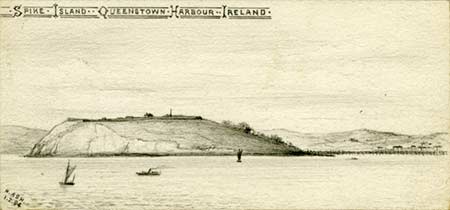
February 1, 1884
Spike Island, Queenstown Harbour, Ireland
Atlantic Cable Website AC-03 |

February 1, 1884
Queenstown Harbour, Ireland
[CS Faraday at right]
Atlantic Cable Website AC-04 |

February 2, 1884
View from Queenstown Harbour, Ireland, Looking Westward
Atlantic Cable Website AC-05 |

February 2, 1884
Entrance to Queenstown Harbour, Ireland
Atlantic Cable Website AC-06 |

February 2, 1884
View near the town of Queenstown, Ireland
Atlantic Cable Website AC-07 |
New York Times: LONDON, Feb. 21, 1884. The steamer Faraday, which left Queenstown some time ago with a portion of the new Mackay cable on board, has returned to Portland. She has lost her port propeller, and is coming to London for survey.
The Faraday is owned by the Siemens Company, of London, who have contracted to lay the new cable. It does not become the property of the Bennett-Mackay Commercial Company until
it is completed and has been in good working order for 30 days. The Faraday hes been out about 16 days, but made frequent stops to take soundings. George G. Ward, the Superintendent of the Commercial Company's affairs in this country, said last night that the mishap would cause no delay in completing the work by next Fall.
Note: On 2 February 1884 the Faraday left Queenstown to lay the first section of the Commercial Cable Company's Atlantic cable. On 7 February the ship ran into a gale which lasted for over a week, causing considerable damage; a second gale on the 17th caused further damage. This caused a two-month delay in the project.
New York Times: LONDON, April 16, 1884. The steam-ship Faraday cleared for Nova Scotia today. She carriers the first installment of the Mackay-Bennett cable to the amount of 1,100 miles.
New York Times: HALIFAX, Nova Scotia, May 6, 1884. The steamer Faraday, with the Bennett-Mackay cable on board, has arrived in Dover Bay. A telegram from Torbay reports the sea smooth and the weather fine, with a north-west breeze. |
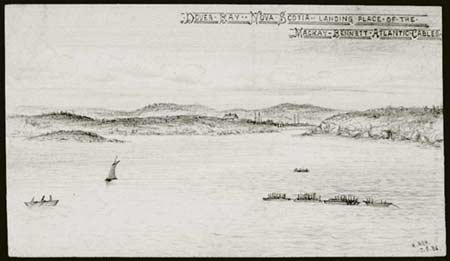
May 7, 1884
Dover Bay, Nova Scotia: Landing Place of the Mackay-Bennett Atlantic Cable
Library and Archives Canada -
Henry Ash Fonds: e04414142 |

May 8, 1884
Mackay-Bennett Cable House, Dover Bay, Nova Scotia
Library and Archives Canada -
Henry Ash Fonds: e04414143 |
| New York Times: ROCKPORT, Mass., May 15, 1884.
The steamer Faraday, with the American section of the Mackay-Bennett oceanic cable aboard, was expected to arrive here from Nova Scotia the first or middle of the week. Unforeseen events, however, have delayed her progress considerably. Immediately on her arrival at Dover Bay, Nova Scotia, on Tuesday of last week, she laid about 80 miles of the transoceanic line. Then, having buoyed the sea end, she returned, to port, laid the heavy shore end of the American section, and had paid out about 31 miles of deep-sea cable when Mr. Brittle, chief of the electricians aboard, received a message ordering him to pick up all that had been laid to within six miles of shore. This was successfully done, though only with the exercise of much care. The company had, at the last moment, determined to take a more southerly course than that first laid out, to avoid the fishing grounds. This involved the use of over 40 miles more of cable. The Faraday started anew and had paid out about 158 miles, then cut the cable and buoyed the sea end just off Cape Sable, and proceeded back to Canso to take the additional cable needed. She left Canso on Monday afternoon at 6 o'clock, and yesterday morning picked up the cable where she left it, spliced the ends, and was yesterday reported steaming toward Cape Ann. Advices received to-day however, state that the Faraday has put back to Halifax and is taking in coal, and it is now thought she will not arrive here before Saturday or Sunday. |

May 16, 1884
On the North West Arm, Halifax, Nova Scotia [May 16th, 1884]
Library and Archives Canada -
Henry Ash Fonds: e04414144 |
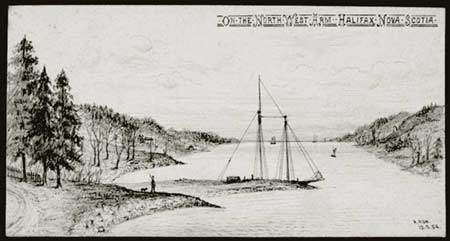
May 19, 1884
On the North West Arm, Halifax, Nova Scotia [May 19th, 1884]
Library and Archives Canada -
Henry Ash Fonds: e04414145 |
New York Times: HALIFAX, Nova Scotia, May 19, 1884. The cable steamer Faraday, which is engaged in laying the Bennett-Mackay cable, sailed hence this evening for Cape Ann. She will take up the end of the cable, which is buoyed off the harbor, and proceed with the work.
New York Times: ROCKPORT, Mass., May 21, 1884. Rockport townspeople are getting a little impatient over the delay of the Faraday, which was expected here from Dover Bay, Nova Scotia, a full week ago, with the Mackay-Bennett ocean cable in her trail. |

May 22, 1884
Thatchers Island Lights & Milk Island off Cape Ann, North America
Library and Archives Canada -
Henry Ash Fonds: e04414149 |
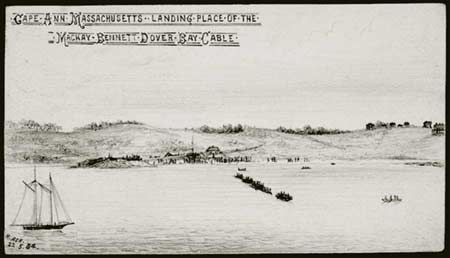
May 22, 1884
Cape Ann, Massachusetts. Landing Place of the Mackay-Bennett Dover Bay Cable
Library and Archives Canada -
Henry Ash Fonds: e04414146 |
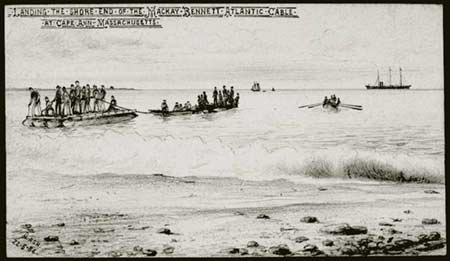
May 22, 1884
Landing the shore end of the Mackay-Bennett Atlantic Cable at Cape Ann, Massachusetts
Library and Archives Canada -
Henry Ash Fonds: e04414147 |
| New York Times: ROCKPORT, Mass. The cable will come ashore on Cape Hedge, on the south side of Cape Ann, about two and a half miles from the centre of the town. Near the beach a testing station is being built and is nearly complete. An operator will live there while the testing preliminary to the delivery of the cable to the company is going on, and this may last several weeks. The Wards are aiso negotiating for a site for the business station in town, to which station the cable will be extended under ground. The plans for this station contemplate a modest. but attractive, little structure of one and a half stories, in which provision has been made for the operating-room, Superintendent's office, testing and battery rooms, and work-room. |

May 22, 1884
Mackay-Bennett Cable House, Cape Ann, Massachusetts
Library and Archives Canada -
Henry Ash Fonds: e04414148 |
New York Times: ROCKPORT, Mass., May 22, 1884. It was the unexpected which happened to-day in the Mackay-Bennett cable matter. The townspeople, by reason of the long series of disappointments they had experienced, had settled down to a skeptical attitude and become disinclined to accept any reports of the Faraday's speedy arrival. And so it happened that the steamer came, landed the shore cable, and steamed off beyond the horizon almost before the Cape Ann people had fairly realized the fact that the thing was being actually accomplished.
[more...]. |
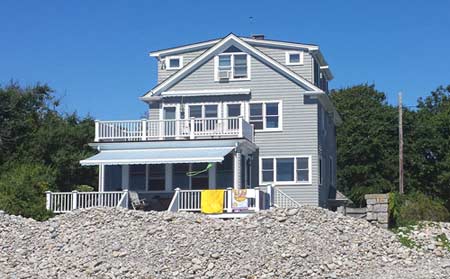
The original cable hut is unrecognizable in
this view of the site taken in August 2013
Image courtesy of and copyright © 2013 Maciej Wrobleski
|
New York Times: LONDON, June 21, 1884. The Faraday will leave the Thames on Monday [June 23] with 5,000 tons of cable. She will proceed at once to Waterville Bay, on the Kerry coast of Ireland, and lay the shore end or heavy type of cable, in the same manner as at Rockport, Mass. This work will probably be completed by Friday afternoon, when the connection with the deep-sea portion will be made and the course of the ship laid for the buoy which she left in mid-ocean a few weeks ago, and to which is attached the American half of the cable. The buoy will probably be reached by the 20th of July, when by splicing the end attached to the buoy, and that end on board the ship, the circuit will be completed between England and America, and, barring accident, the first of the two proposed Mackay-Bennett cables will be in working order.
New York Times: June 25, 1884. The steamer Faraday passed the Lizard to-day after laying the shore end of the Mackay-Bennett cable to Waterville. She goes to Cork to coal, and will then complete the cable. |
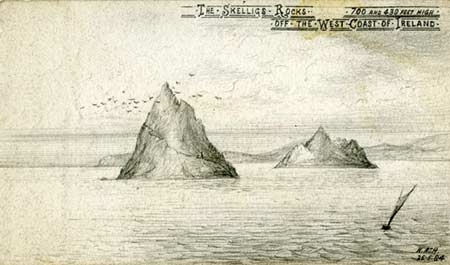
June 26, 1884
The Skelligs Rocks. 700 and 430 Feet High,
off the West Coast of Ireland
Atlantic Cable Website AC-08 |
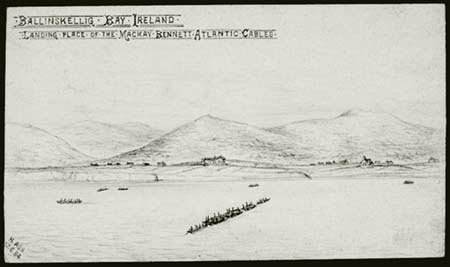
June 27, 1884
Ballinskellig Bay Ireland, landing place of the Mackay Bennett Atlantic Cables
Library and Archives Canada -
Henry Ash Fonds: e04414150 |
New York Times: June 29, 1884. The steam-ship Faraday, which left London on Monday last [June 23] with the second or eastern section of the first Bennett-Mackay cable on board, has been hard at work during the past day or two in Waterville Bay, on the Kerry coast of Ireland, laying the heavy shore ends necessary at that point. When she has completed this work, which will probably be by to-morrow night, she will proceed to Cork, or some other convenient port, for a fresh supply or coal. The last link, the deep-sea section, will then be laid.
New York Times: London, July 3 1884. The Faraday has laid the 200 miles of the eastern shore end of the Mackay-Bennett cable and has returned to Queenstown for coal. She will now proceed to lay the remainder of the deep-sea portion.
New York Times: London, July 9 1884. A dispatch received
last evening from the steamer Faraday, which is
engaged in laying. the Mackay-Bennett cable,
states that she had picked up the Irish coast end
200 miles out, and had laid 250 miles more. The
weather was fine, and it was expected that the
work of laying the entire cable would soon be
completed.
New York Times: London, July 19, 1884. There is great rejoicing in Waterville to-night over a message just received from the electricians on the steamer Faraday who are laying the new Mackay-Bennett cable. They have kept themselves constantly in communication with the Irish terminus at Waterville through the cable which they are
laying, and this evening the officials on shore received the welcome news
that the Faraday had arrived at the buoy in midocean which marks the end of that
portion of the line which was laid from America. The news was soon spread to London and Paris, and messages of congratulation have ever since been pouring in to the little office at Waterville,
where the event is being celebrated with copious libations of champagne.
New York Times: London, Aug. 26, 1884. The steamship Faraday has laid the first deep sea portion of the second Mackay-Bennett cable, and is now returning to Woolwich to receive the remainder of the deep sea portion and the American shore end. |
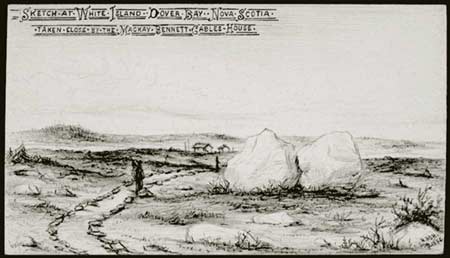
October 9, 1884
Sketch at White Island, Dover Bay, Nova Scotia taken close by the MacKay Bennett Cables House
Library and Archives Canada -
Henry Ash Fonds: e04414151 |

October 18, 1884
Coney Island near New York landing place of the MacKay Bennett Dover Bay Cable
Library and Archives Canada -
Henry Ash Fonds: e04414152 |
New York Times: Oct. 18, 1884. The new Mackay-Bennett cable, one end of which arrived off Manhattan Beach on Thursday morning, is not yet landed, owing to another accident which occurred yesterday. The men on board the Faraday, the cable steamer, did not cease their work of coiling the cable on the rafts moored beside the ship until late on Thursday night.
New York Times: Oct. 19, 1884. After all delays the new Mackay-Bennett ocean cable found a safe resting place for its American end at 12:30 o'clock yesterday, in the pretty little cottage prepared for its reception on Manhattan Beach, just east of the Oriental Hotel.
New York Times: Oct. 20, 1884. The cable ship Faraday, having on board the shore end of the cable, left her anchorage off Manhattan Beach early on Saturday night and steamed off toward the spot, 85 miles distant, where she has left the end of the main cable anchored and buoyed, paying out the wire all the way. She probably did not reach the main cable until last night, and the splicing of the two cables will not be completed until some time this afternoon, possibly not until tomorrow. |

October 22, 1884
The Lakes, Dartmouth near Halifax, Nova Scotia
Library and Archives Canada -
Henry Ash Fonds: e04414153 |
New York Times: HALIFAX, Nova Scotia, Oct. 25, 1884. The steamer Faraday, which arrived from New-York to-day, will take 2,000 tons of coal on board. She will remain until the first of the week, and then proceed to sea to find and repair the broken portion of the first Mackay-Bennett cable.
New York Times: LONDON, Nov. 8, 1884. Communication with America through the new Mackay-Bennett cables has now ceased entirely. It is believed at the London office that the damage has been caused by icebergs off the Banks of Newfoundland. It is hoped here that the cable officials in New-York will be able to communicate soon with the Faraday, and that repairs be proceeded with forthwith.
New York Times: NEW-YORK, Dec. 10, 1884. The laying of the cables of the Commercial Cable Company through the streets of this city, from the New-York anchorage of the bridge to the company's office at Wall and Broad streets, has been practically completed. As soon as the necessary splices are made at the bridge anchorage and at the hut on Coney Island telegraphic communication will be opened between New-York and Ireland. It is expected that this will be done next Friday. The steamship Faraday is now looking for the break in the southern cable. |

December 24, 1884
St. John's, Newfoundland from outside the harbour
Library and Archives Canada -
Henry Ash Fonds: e04414154 |
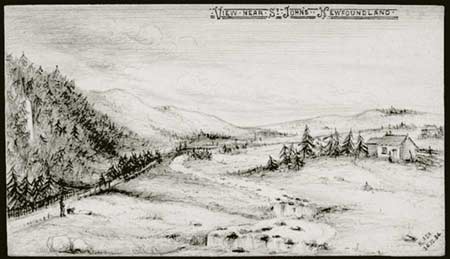
December 24, 1884
View near St. John's, Newfoundland
Library and Archives Canada -
Henry Ash Fonds: e04414155 |
New York Times: June 10, 1885. The steamer Faraday has completed the laying of the commercial cable section from Waterville, Ireland, to Weston-super-Mare, England.
New York Times: Sep. 9, 1885. The cable steamship Faraday, Capt. Le Fanu, passed the Isle of Wight today. |
Henry Ash Fonds images
copyright © 2006, Library
and Archives Canada. Reproduced by permission. |
Based on some of the sketches above, Henry Ash created a coloured lithograph which was published by Maclure & Co. of London. The date is unknown, but presumably some time during 1885. A copy of the lithograph is in the collection of the National Maritime Museum, London, object ID PAH0368.
At the centre of the lithograph:
CS Faraday (1)
Vignettes (left to right, top row first):
Landing Place, Coney Island, America
Cable Works, Charlton, England
Waterville, Ireland Landing Place
Cable House, Cape Ann, Massachusetts
Landing a Shore End
Cable House, Dover Bay, Nova Scotia
Between the vignettes are other small elements, including two cable marker buoys and cross sections of the cable.
Some of the vignettes are exact copies of pencil sketches shown on this page. |

